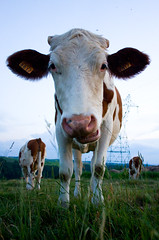Warning: I'm going to try to keep this simple, but it's not an easy subject once you get past the intro. Feel free to ask questions if you want clarification or more info, I'm happy to to explain anything in more depth.
I come across articles about feeding cattle fairly regularly on various news agencies. More so in the past few months than usual, probably due to the drought this summer and concern over food costs. Each time I do, I try to make my way through the comments to see how people are responding and what they think. Almost every time I see several comments in the vein of "cattle should only eat grass not [
grain...
candy...
byproducts...etc]."
While there is a whole host of reseach out there about the differences between grass and grain fed beef, that's a dscussion for another day. And one I'm more than willing to have. You might be suprosed about this beef nutritionist's thoughts. (Hint: I like both and think they both have a place).
 |
| Rumen diving at it's finest. |
The bigger point for me here comes when comments like the example above are followed by some statement about how the cattle need the grass because the other feed is unhealthy or not natural. And this my readers is where we
dive back into the rumen.
The rumen basically just functions as a
fermentation tank for a plethora of microorganisms. Bacteria, fungi, and protozoa love that place! One of the first tenets of feeding cattle (or any ruminant) is that you aren't. What you are doing is feeding the microbes. The microbes
digest the food the cattle eats, turning it into the nutrients the animal absorbs and utilizes for energy, muscle building, etc.
Now, I'm not saying that we can't alter the microbial products by altering the diet. We
can and
do. But, the microbes are not overly particular about the form of their nutrients. They really just want the carbon and nitrogen and other elements to pull off for their own needs. Everything else is waste, which is rearranged by a series of reactions into a fairly standard set of molecules that the cattle then use.
This is where that warning comes in. This is a whole semester of ruminant nutrition as short and sweet as possible.
For example: Let's say I feed my cow some grass. The microbes don't really care that it's grass. They digest the
cellulose and other starches to get into the center of each tiny cell in that grass. That's where the good stuff is. Proteins,
amino acids, and so much more. When the cellulose is broken down it is rearranged into several products. The most important of which are
volatile fatty acids (especially acetate, propionate, and butyrate). These are the main players for energy in cattle.
The big picture here is that the microbes don't care about the original source of the carbon and nitrogen they stick back together to make VFAs. It just happens. You or I can eat meat or beans. The proteins from either get broken down to amino acids either way. The microbes in the rumen are similar, they just happen to break down materials that you and I never could becuase they have a different set of enzymes.

As always, there is my caveat that this is not a simple process. The diet fed to cattle still has to have the right
balance of proteins, carbohydrates, minerals, vitamins, etc. Without that we do end up with unhealthy animals. No one wants that. I and every farmer I know hates having sick animals. We feel for them when they are
hurting. But we can continue to create that balance using unusual feeds to provide safe, healthy meat; when they are available, cost effective, and fit the needs of the animals and producer. If they don't go to cattle or other animals, they go to the land fill. At least this way the waste fills a niche and leaves more corn, wheat, etc for straight human use.
That's my 5 minute ruminant nutrition lesson for the week, thanks for stopping by. As always, let me know if you want more!




























